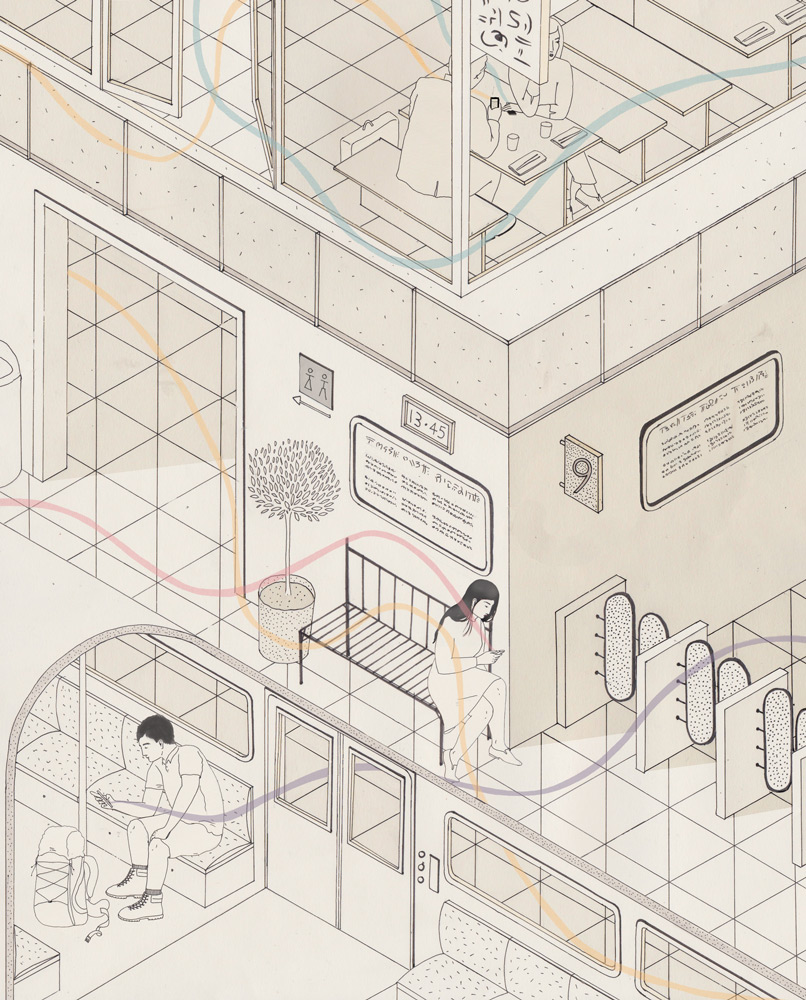Priority Boarding
Airlines are using new technologies to create seamless, personalised journeys for travellers, from pre-trip planning right through to post-flight city experiences

“If you want to be a millionaire, start with a billion dollars and launch a new airline,” the founder of Virgin Airlines Richard Branson, is reported to have said.
Turbulent fuel prices, 9/11, a lingering global recession – even an Icelandic volcano – have conspired against air travel, which has shown a slow rate of growth in the last few years. But now global air travel is on the rise once more, buoyed by growing prosperity in Asia and Latin America. The International Air Transport Association (IATA) predicted late last year that passenger demand will grow by 31% between 2013 and 2017, raising total passenger numbers to a staggering 3.91bn.
But ubiquitous mobile, social and digital technology has bred a new form of traveller, explains Stephane Cheikh, innovation manager at SITA, the air transport communications and information technology body: “Passengers are becoming more technologically aware and are used to being connected all the time. This is driving expectations about where airports and airlines have to invest.”
More than 90% of airline passengers say technology helps them when travelling, according to a SITA survey carried out last year. Although more than 75% of passengers carry a smartphone, passengers rarely make use of mobile services such as booking and check-in, which stand at below 5%.
Data is knowledge, and wielding it wisely lets airlines build better relationships with their customers.

“Improving usability and utilising the unique capabilities of smartphones is the key to increased usage,” said Francesco Violante, SITA’s CEO, in the organisation’s 2013 Passenger IT Trends Survey. “Airlines and airports that recognise this, and provide passengers with easy-to-use mobile services that improve the travel experience, will enjoy higher adoption rates and passenger satisfaction.”
Hustling for passengers, the travel industry is steering a new course where digital services are created around travellers’ needs at every stage. “It’s important that the airlines offer an integrated set of tools rather than a bolt-on to the existing systems,” said Paul Behan, IATA’s head of customer experience, last year.
Fuelled by an explosion of innovations, including wearable technology, beacons, biometric authentication, robotics and big data analytics, the travel industry is working to create a seamless experience for today’s travellers, from the moment they start to plan their trip, through to making bookings, travelling to the airport, navigating the airport, and even when they’ve reached their destination.
Getting Social and Personal
Take data, the exhaust fumes of the lives we increasingly live online, for example Airlines like EasyJet and KLM are using this virtual detritus to create detailed profiles of visitors on customer relationship management systems. Why? Because data is knowledge, and wielding it wisely lets airlines build better relationships with their customers.
EasyJet changed strategy to focus on customer service in 2011, which it’s delivering through clever digital thinking. It has built up detailed profiles of flyers and uses that data to send tailored messages. Booked a flight to Barcelona for you and your girlfriend last year? You might get a reminder email around the same time this year to nudge you to do something similar.
Emirates, Iberia and British Airways, meanwhile, use data to improve customers’ experiences in the air. Stewards on BA are armed with iPads fed with information about its first class and business travellers through the enhanced services platform. This allows them to know about a traveller’s requirements, such as meal preferences and onward travel plans at the touch of a button.
Dutch carrier KLM, meanwhile, uses social data to create personalised services such as Meet & Seat. Passengers looking for like-minded travellers while flying can share their LinkedIn, Facebook or Google+ data and find out if anyone with similar interests is on the flight. KLM’s Must See Map enables visitors to create a personalised city map filled with tips from friends collected through email and social media.
Your Pocket Travel Companion
Data can help personalise experiences, but mobile technology means airlines are able to reach passengers long before they get anywhere near the airport.
Take Delta, who have committed to creating winning customer service, breaking down silos in the business to reorganise around the customer journey. To help do this, they’ve developed an app to assist customers at all points of their journey. At the planning stage, their Fly Delta app can recommend holiday destinations based on your budget or personal interests. Once booked, it lets users plan their entertainment for the flight beforehand, even suggesting films based on the destination, such as Belle de Jour on flights to Paris.
The app also plays a big role in making the in- flight experience more pleasant. Travellers can browse expansive digital travel guides of their destination long before they land, and the nifty Glass Bottom Jet feature lets them see what’s on the ground below them, along with tagged points of interest. Fliers can even connect with their social network contacts at 30,000ft as well as having the ability to track luggage at all stages.

Showing the public’s appetite for such measures, the app’s been downloaded more than 5.5m times. It’s one of a number of steps that helped lift Delta from near bankruptcy to healthy profits, to bring it a bulging trophy cabinet of customer service awards and to be named as Fortune magazine’s global airline of the year in 2013.
Not to be left on the runway, other airlines are experimenting with end-to-end services too. Beyond flight information and boarding passes, airlines including Qantas, and airport operators in South Africa and Italy have introduced services such as real- time traffic updates and airport parking booking tools.
Japan Airlines has integrated shopping coupons into its mobile app, while Copenhagen airport has created an app that translates signage into Chinese and provides in-airport directions to help fliers find their way around.
Expanding services for customers beyond the flight itself reaps dividends for airlines as much as for travellers: Delta reports that up to 11% of its revenues come from ancillary services.
Sensory Overload
Beacons – small wireless sensors that communicate with smartphones over low-energy Bluetooth – are a big part of the new future of travel, reckons Cheikh. Offering micro-context and tailored shopping offers to globetrotters, among other nifty functionality, they are projected to hit five million units in five years, according to Business Insider Intelligence, and are set to revolutionise contextual messaging in retail.
Cheikh’s team is deploying 270 beacons in Miami International Airport alone, and is also working with American Airlines to install the devices at the airline’s flight hubs. Attached to airport walls and shop entrances, beacons serve a number of purposes: for example, at security, they can tell a passenger whether to rush for their flight or whether to hang around for a bite or to do some shopping, depending on their flight and distance from the gate. SITA is pushing for common use, so that different airlines can tap into the sensors to send messages to their passengers.
“Beacons give airports an advantage, because they know when passengers are going through the airport, and can provide them with the right information, at the right time,” says Cheikh. This can range from information about the airport and ight, discounts for the shop they’re in, or a late up-sell for on- ight meals and seats
Wear\(ables\) Next?
What’s next for passengers then? Cheikh thinks wearable technology, robots and biometric identification technology are poised to take off, dramatically improving the customer service provided by airlines and airport staff, and unclogging the bottleneck caused by identity checks.
“We’re looking with IATA at a project called the Single Token,” he enthuses. “It’s idealistic, but imagine the passenger would be able to go through the entire airport journey without showing any type of identification.”
In the shorter term, he points to a host of recent trials undertaken by SITA as evidence for wearables’ potential to streamline waiting times and provide premium, personalised services. Even before the grand unveiling of the Apple Watch, analysts Canalys projected that 45m wearables could be sold every year by 2017, up from 17m in 2014.
In Copenhagen Airport, for example, SITA equipped airport staff with Google Glass, enabling them to help passengers with basic queries about their ights. Staff bene ted because the information they needed was right in front of their eyes. “Passengers were very surprised and happy: staff were able to provide information
in seconds,” says Cheikh.
Even smarter still, Virgin Atlantic experimented with the headsets and smart watches, for its Upper Class Wing travellers at Heathrow Airport, alerting staff instantly to a new visitor’s arrival, using Google Glass, passenger’s details were presented to attendants as soon as they arrived. Staff were able to provide information such as flight boarding times, how many aisle or window seats were left, and the weather at their destination.
Perhaps in the future we won’t be greeted by people at all. SITA is collaborating with technology start-up Double Robotics on robots with tablets that feature a live stream of an airport staff member on screen – think an iPad on a Segway – ushering people from one gate to another, all controlled from a remote station.
In an even more tech-heavy example, British Airways recently experimented with a piece of equipment they dubbed the ‘Happiness Blanket’. Passengers were fitted with neuro-sensors that were connected to LED ifbers woven into their blankets. These would glow red or blue depending on their comfort levels, helping flight staff assess passenger’s wellbeing.
Jet-setters might have to wait a while for these developments to make their way onto commercial flights, but while they do, they can expect the travel industry to keep finding ways of using emerging technology to take the turbulence out of their next trip.


